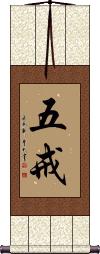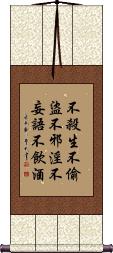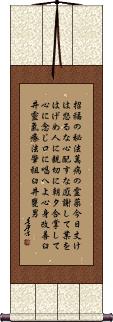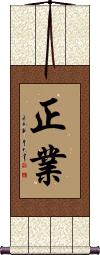Many custom options...
And formats...

Five Precepts in Chinese / Japanese...
Buy a Five Precepts calligraphy wall scroll here!
Personalize your custom “Five Precepts” project by clicking the button next to your favorite “Five Precepts” title below...
Five Precepts
五戒 is the title or name for the five precepts of Buddhism.
These are prohibitions against killing, theft, sexual misconduct, lying, and intoxication.
Also phrased as commandments against murder, stealing, adultery, false speech, and consuming intoxicating liquors.
These five precepts or “pañca-veramaṇī” apply to the Buddhist laity as well as monks and nuns. The observance of these five ensures rebirth in the human realm.
Five Precepts
不殺生不偷盜不邪淫不妄語不飲酒 is the full list of the five precepts of Buddhism in Chinese.
There are many ways to translate or express these.
The following is one basic way:
1. Do not kill/murder.
2. Do not steal.
3. Do not commit adultery and/or sexual misconduct.
4. Do not lie or speak falsehoods.
5. Do not become intoxicated (with drugs/alcohol).
Here is another take from my favorite magazine: Lion's Roar: Five Precepts
Reiki Precepts by Usui Mikao
These are the precepts of Reiki that are attributed to Usui Mikao.
Here is a breakdown of the characters and a rough translation:
招福の秘法, 萬病の霊薬。
Invite blessings of [the] secret method, 10,000 illnesses of spiritual medicine.
今日丈けは: 怒るな, 心配すな, 感謝して, 業をはげめ, 人に親切に。
At least for today: Do not be angry, do not worry, be grateful, work with diligence, and be kind to people.
朝夕合掌して, 心に念じ, 口に唱へよ, 心身改善。
Morning [and] evening perform gassho (join hands), [with your] heart/mind in silent prayer, [with your] mouth chant, [thusly] mind [and] body [will] reform/improve.
臼井靈氣療法! -肇祖, 臼井甕男。
Usui Reiki Ryōhō! -Founder, Usui Mikao.
The middle portion of this is often titled, “The Five Principles of Reiki” and makes a nice calligraphy selection by itself. The Japanese text presented here can be considered the more verbose version.
Note: Because this selection contains some special Japanese Hiragana characters, it should be written by a Japanese calligrapher.
4. Right Action / Perfect Conduct
Samyak Karmanta / Samma Kammanta
正業 is one of the Noble Eightfold Paths of Buddhism. Right Action, along with Right Speech and Right Living, constitute the path to Virtue.
The five precepts of Right Action are...
1. Refrain from destroying living beings (no murder or any form of taking a life).
2. Refrain from stealing.
3. Refrain from sexual misconduct (adultery, rape, etc.).
4. Refrain from false speech (lying or trickery).
5. Refrain from intoxicants that lead to heedlessness (no drugs or alcohol).
This concept can be summarized as “Avoidance of actions that conflict with moral discipline.”
Note: In Japanese, when read by a non-Buddhist, this will mean “the right job/vocation.”
This term is exclusively used by devout Buddhists. It is not a common term, and is remains an unknown concept to most Japanese and Chinese people.
See Also: Buddhism | Enlightenment | Noble Eightfold Path
Ten Commandments
十戒 means Ten Commandments or Ten Precepts.
In the Buddhist context, these are prohibitions consisting of five commandments for the layman:
1. Not to destroy life 不殺生 Pāṇātipātāveramaṇi.
2. Not to steal 不倫盜 Adinnādānāver.
3. Not to commit adultery 不婬慾 Abrahmacaryaver.
4. Not to lie 不妄語 Musāvādāver.
5. Not to take intoxicating liquor 不飮酒 Suramereyya-Majjapamādaṭṭhānāver.
The ten commandments for the monk are the preceding five plus:
6. Not to eat food outside of regulated hours 不非時食 Vikāla-Bhojanāver.
7. Not to use garlands or perfumes 不著華鬘好香塗身 Mālā- Gandha-Vilepana-Dhāraṇa-Maṇḍana-Vibhūṣanaṭṭhānā.
8. Not to sleep on high or broad beds (chastity) 不坐高廣大牀 Uccāsayanā-Mahāsayanā.
9. Not to take part in singing, dancing, musical or theatrical performances 不歌舞倡伎不往觀聽 Nacca-Gīta-Vādita-Visūkadassanāver.
10. To refrain from acquiring uncoined or coined gold, or silver, or jewels 不得捉錢金銀寶物 Jātarūpa-Rajata-Paṭīggahaṇāver.
These original Buddhist commandments date back to about 2500 years ago. The English definitions above are followed by Chinese characters and original Pali pronunciation.
Under the Māhayāna Buddhism, these ten commands for the monk were changed, to accord with the new environment of the monk, to the following: not to kill, not to steal, to avoid all unchastity, not to lie, not to slander, not to insult, not to chatter, not to covet, not to give way to anger, to harbor no skepticism.
Not the results for five precepts that you were looking for?
Below are some entries from our dictionary that may match your five precepts search...
| Characters If shown, 2nd row is Simp. Chinese |
Pronunciation Romanization |
Simple Dictionary Definition |
五戒 see styles |
wǔ jiè wu3 jie4 wu chieh gokai ごかい |
More info & calligraphy: Five Preceptspañca-veramaṇī; the first five of the ten commandments, against killing, stealing, adultery, lying, and intoxicating liquors. 不殺生; 不偸盜; 不邪婬; 不妄語; 不飮酒 They are binding on laity, male and female, as well as on monks and nuns. The observance of these five ensures rebirth in the human realm. Each command has five spirits to guard its observer 五戒二十五神. |
十戒 see styles |
shí jiè shi2 jie4 shih chieh jukkai じゅっかい |
More info & calligraphy: Ten Commandments(1) (Buddhist term) the 10 precepts; (2) Ten Commandments; Decalogue; Decalog; (surname) Jukkai Śikṣāpada. The ten prohibitions (in Pāli form) consist of five commandments for the layman: (1) not to destroy life 不殺生 pāṇātipātāveramaṇi; (2) not to steal 不倫盜 adinnādānāver; (3) not to commit adultery 不婬慾 abrahmacaryaver.; (4) not to lie 不妄語musāvādāver.; (5) not to take intoxicating liquor 不飮酒 suramereyya-majjapamādaṭṭhānāver. Eight special commandments for laymen consist of the preceding five plus: (6) not to eat food out of regulated hours 不非時食 vikāla-bhojanāver.; (7) not to use garlands or perfumes 不著華鬘好香塗身 mālā- gandha-vilepana-dhāraṇa-maṇḍana-vibhūṣanaṭṭhānā; (8) not to sleep on high or broad beds (chastity) 不坐高廣大牀 uccāsayanā-mahāsayanā. The ten commandments for the monk are the preceding eight plus: (9) not to take part in singing, dancing, musical or theatrical performances, not to see or listen to such 不歌舞倡伎不往觀聽 nacca-gīta-vādita-visūkadassanāver.; (10) to refrain from acquiring uncoined or coined gold, or silver, or jewels 不得捉錢金銀寶物 jātarūpa-rajata-paṭīggahaṇāver. Under the Māhayāna these ten commands for the monk were changed, to accord with the new environment of the monk, to the following: not to kill, not to steal, to avoid all unchastity, not to lie, not to slander, not to insult, not to chatter, not to covet, not to give way to anger, to harbour no scepticism. |
戒 see styles |
jiè jie4 chieh kai; ingoto(ok) かい; いんごと(ok) |
to guard against; to exhort; to admonish or warn; to give up or stop doing something; Buddhist monastic discipline; ring (for a finger) (1) (かい only) {Buddh} admonition; commandment; (2) sila (precept) śīla, 尸羅. Precept, command, prohibition, discipline, rule; morality. It is applied to the five, eight, ten, 250, and other commandments. The five are: (1) not to kill; (2 ) not to steal; (3) not to commit adultery; (4) not to speak falsely; (5) not to drink wine. These are the commands for lay disciples; those who observe them will be reborn in the human realm. The Sarvāstivādins did not sanction the observance of a limited selection from them as did the 成實宗 Satyasiddhi school. Each of the five precepts has five guardian spirits, in all twenty-five, 五戒二十五神. The eight for lay disciples are the above five together with Nos. 7, 8, and 9 of the following; the ten commands for the ordained, monks and nuns, are the above five with the following: (6) not to use adornments of flowers, nor perfumes; (7) not to perform as an actor, juggler, acrobat, or go to watch and hear them; (8) not to sit on elevated, broad, and large divans (or beds); (9) not to eat except in regulation hours; (10) not to possess money, gold or silver, or precious things. The 具足戒full commands for a monk number 250, those for a nun are 348, commonly called 500. Śīla is also the first of the 五分法身, i.e. a condition above all moral error. The Sutra of Brahma's Net has the following after the first five: (6) not to speak of the sins of those in orders; (7) not to vaunt self and depreciate others; (8) not to be avaricious; (9) not to be angry; (10) not to slander the triratna. |
三戒 see styles |
sān jiè san1 jie4 san chieh sankai さんかい |
(1) (from the Analects of Confucius) three lifetime commandments (youth's femininity, middle-aged struggle, old-age gain); (2) {Buddh} three categories of precepts (lay, ordination, moral) The three sets of commandments, i.e. the ten for the ordained who have left home, the eight for the devout at home, and the five for the ordinary laity. |
五篇 see styles |
wǔ piān wu3 pian1 wu p`ien wu pien go hen |
five categories of precepts |
八戒 see styles |
bā jiè ba1 jie4 pa chieh hakkai; hachikai はっかい; はちかい |
the eight precepts (Buddhism) {Buddh} (See 五戒) the eight precepts (the five precepts with the addition of prohibitions against lying in a luxurious bed, self-decoration, song and dance, and eating after noon) (八戒齋) The first eight of the ten commandments, see 戒; not to kill; not to take things not given; no ignoble (i.e. sexual) conduct; not to speak falsely; not to drink wine; not to indulge in cosmetics, personal adornments, dancing, or music; not to sleep on fine beds, but on a mat on the ground; and not to eat out of regulation hours, i.e. after noon. Another group divides the sixth into two―against cosmetics and adornments and against dancing and music; the first eight are then called the eight prohibitory commands and the last the 齋 or fasting commandment. Also 八齋戒; 八關齋 (八支齋) ; cf. 八種勝法. |
戒力 see styles |
jiè lì jie4 li4 chieh li kairiki |
The power derived from observing the commandments, enabling one who observes the five commandments to be reborn among men, and one who observes the ten positive commands 十善 to be born among devas, or as a king. |
篇聚 see styles |
piān jù pian1 ju4 p`ien chü pien chü hen ju |
Two divisions of wrong-doing, one called the 五篇 five pian, the other the six and seven ju. The five pian are: (1) pārājika, v. 波, sins demanding expulsion from the order; (2) saṅghāvaśeṣa, v. 僧, sins verging on expulsion, which demand confession before and absolution by the assembly; (3) ? prāyaścitta, v. 波逸, sins deserving hell which may be forgiven; (4) pratideśanīya, v. 波羅 and 提舍, sins which must be confessed; (5) duṣkṛta, v. 突, light sins, errors, or faults. The six ju are the five above with sthūlātyaya, v. 偸, associated with the third, implying thought not developed in action. The seven ju are the above with the division of the fifth into two, action and speech. There are further divisions of eight and nine. |
三歸戒 三归戒 see styles |
sān guī jiè san1 gui1 jie4 san kuei chieh sanki kai |
ceremony for the acceptance of the five precepts |
五戒賢 五戒贤 see styles |
wǔ jiè xián wu3 jie4 xian2 wu chieh hsien gokai ken |
worthies adhering to the five precepts |
五百戒 see styles |
wǔ bǎi jiè wu3 bai3 jie4 wu pai chieh gohyaku kai |
The 'five hundred ' rules for nuns, really 348, viz. 8 波羅夷, 17 僧殘, 30 捨墮, 178 單提, 8 提捨尼, 100 衆學, and 7 滅諍. |
受五戒 see styles |
shòu wǔ jiè shou4 wu3 jie4 shou wu chieh jugokai |
receiving the five precepts |
小乘戒 see styles |
xiǎo shèng jiè xiao3 sheng4 jie4 hsiao sheng chieh shōjō kai |
The commandments of the Hīnayāna, also recognized by the Mahāyāna: the five, eight, and ten commandments, the 250 for the monks, and the 348 for the nuns. |
戒取見 戒取见 see styles |
jiè qǔ jiàn jie4 qu3 jian4 chieh ch`ü chien chieh chü chien kaishu ken |
戒禁取見 Clinging to heterodox ascetic views; one of the five darśana 五見. |
三歸五戒 三归五戒 see styles |
sān guī wǔ jiè san1 gui1 wu3 jie4 san kuei wu chieh sanki gokai |
(三歸戒) The ceremony which makes the recipient a 優婆塞 or 優婆夷 upasaka or upāsikā male or female disciple, accepting the five commandments. There are 五種三歸 five stages of sangui; the first two are as above, at the third the eight commandments are accepted, at the fourth the ten, at the fifth an the commandments. 三歸 is also a general term for a Buddhist. |
世俗五戒 see styles |
shì sú wǔ jiè shi4 su2 wu3 jie4 shih su wu chieh sezoku gokai |
five precepts for laymen |
五八十具 see styles |
wǔ bā shí jù wu3 ba1 shi2 ju4 wu pa shih chü gohachijū gu |
All the five, eight, and ten commandments, i. e. the three groups of disciples, laity who keep the five and eight and monks who keep the ten. |
五常五戒 see styles |
wǔ cháng wǔ jiè wu3 chang2 wu3 jie4 wu ch`ang wu chieh wu chang wu chieh gojō gokai |
five constant virtues and five precepts |
五篇七聚 see styles |
wǔ piān qī jù wu3 pian1 qi1 ju4 wu p`ien ch`i chü wu pien chi chü gohen shichijū |
five and seven categories of precepts |
在家二戒 see styles |
zài jiā èr jiè zai4 jia1 er4 jie4 tsai chia erh chieh zaike nikai |
The two grades of commandments observed by the lay, one the five, the other the eight, v. 五戒 and 八戒; these are the Hīnayāna rules; the 在戒 of Mahāyāna are the 十善戒 ten good rules. |
五戒淸信女 see styles |
wǔ jiè qīng xìn nǚ wu3 jie4 qing1 xin4 nv3 wu chieh ch`ing hsin nü wu chieh ching hsin nü gokai shōshin nyo |
women of pure faith who adhere to the five precepts |
The following table may be helpful for those studying Chinese or Japanese...
| Title | Characters | Romaji (Romanized Japanese) | Various forms of Romanized Chinese | |
| Five Precepts | 五戒 | go kai / gokai | wǔ jiè / wu3 jie4 / wu jie / wujie | wu chieh / wuchieh |
| Five Precepts | 不殺生不偷盜不邪淫不妄語不飲酒 不杀生不偷盗不邪淫不妄语不饮酒 | bù shā shēng bù tōu dào bù xié yín bù wàng yǔ bù yǐn jiǔ bu4 sha1 sheng1 bu4 tou1 dao4 bu4 xie2 yin2 bu4 wang4 yu3 bu4 yin3 jiu3 bu sha sheng bu tou dao bu xie yin bu wang yu bu yin jiu | pu sha sheng pu t`ou tao pu hsieh yin pu wang yü pu yin chiu pu sha sheng pu tou tao pu hsieh yin pu wang yü pu yin chiu |
|
| Reiki Precepts by Usui Mikao | 招福の秘法萬病の霊薬今日丈けは怒るな心配すな感謝して業をはげめ人に親切に朝夕合掌して心に念じ口に唱へよ心身改善臼井靈氣療法肇祖臼井甕男 | shou fuku no hihou man byou no rei yaku kyou da ke wa oko ru na shin pai su na kan sha shi te gyou wo ha ke me hito ni shin setsu ni asayuu gasshou shite kokoro ni nenji kuchi ni tonae yo shin shin kaizen usui rei ki ryou hou cho so usu i mika o sho fuku no hiho man byo no rei yaku kyo da ke wa oko ru na shin pai su na kan sha shi te gyo wo ha ke me hito ni shin setsu ni asayu gasho shite kokoro ni nenji kuchi ni tonae yo shin shin kaizen usui rei ki ryo ho cho so usu i mika o | ||
| 4. Right Action Perfect Conduct | 正業 正业 | sei gyou / seigyou / sei gyo | zhèng yè / zheng4 ye4 / zheng ye / zhengye | cheng yeh / chengyeh |
| Ten Commandments | 十戒 | jukkai / jukai | shí jiè / shi2 jie4 / shi jie / shijie | shih chieh / shihchieh |
| In some entries above you will see that characters have different versions above and below a line. In these cases, the characters above the line are Traditional Chinese, while the ones below are Simplified Chinese. | ||||
Successful Chinese Character and Japanese Kanji calligraphy searches within the last few hours...








